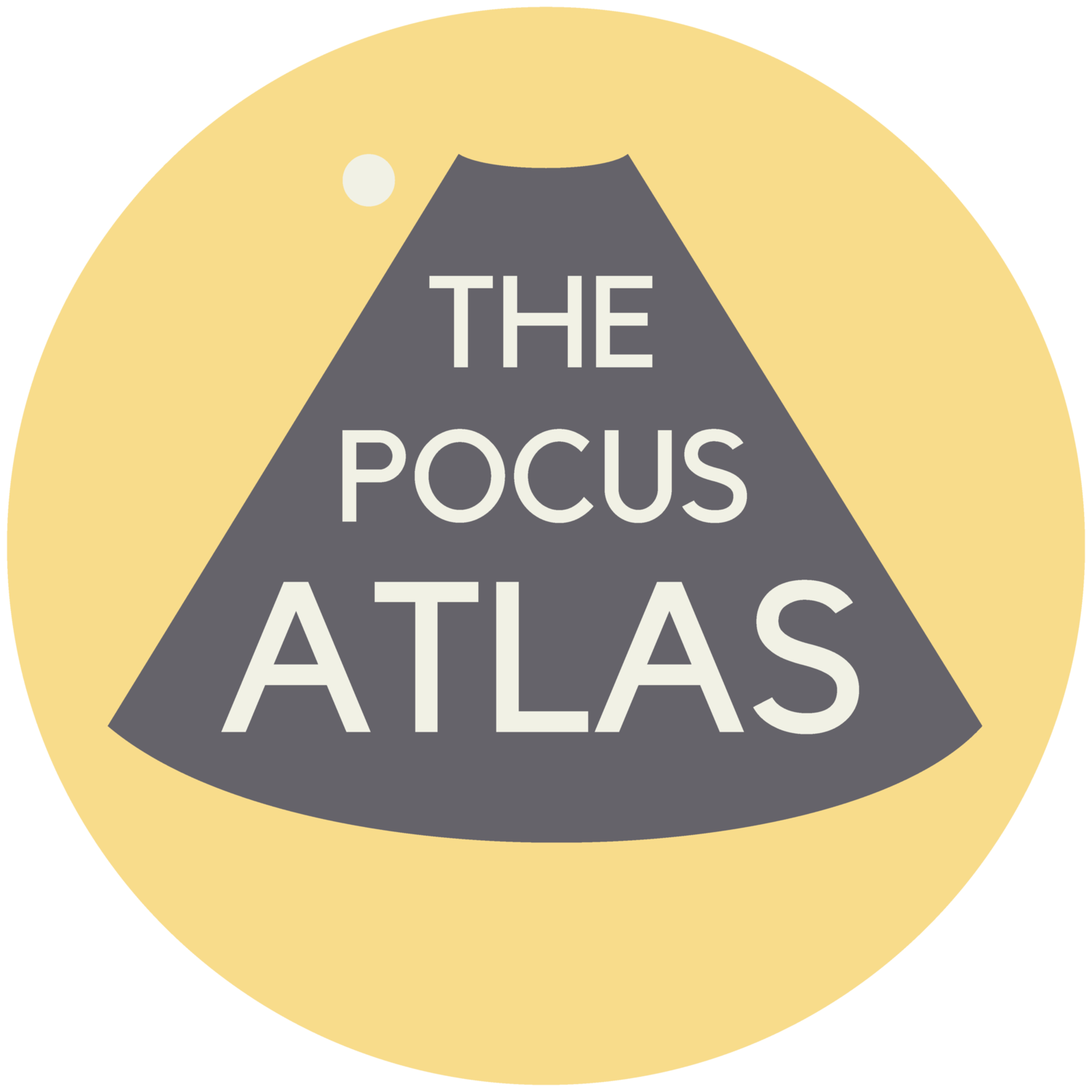
Biliary

Cholelithiasis - Impacted Stone
It’s fundamental to study the gallbladder in its whole extension. In this image, there is an impacted stone at the neck.
Dr. Felipe Urriola P.
www.thepocus.com

Cholelithiasis - Multiple Stones
The gallbladder is studied in both planes, revealing multiple small stones generating acoustic shadowing.
Dr. Felipe Urriola P

Cholelithiasis with Adenomyomatosis
Longitudinal view of the gallbladder revealing two unique findings. A hyperechoic structure with posterior acoustic shadowing indicative of a stone is located in the neck. Two smaller hyperechoic structures can be seen attached to the wall of the GB body, likely adenomyomatosis.
Image courtesy of Robert Jones DO, FACEP @RJonesSonoEM
Director, Emergency Ultrasound; MetroHealth Medical Center; Professor, Case Western Reserve Medical School, Cleveland, OH
View his original post here

Gallstone in Neck Causing Mirizzi's Syndrome
Note the hyperechoic structure with posterior acoustic shadowing indicative of a gallstone. Patient was moved and the stone remained lodged in the neck. Additionally, gallbladder sludge can be seen. The patient was found to have elevated LFTs. MRCP performed demonstrating external compression of biliary tree this large stone in GB neck consistent with Mirizzi’s syndrome.
Image courtesy of Robert Jones DO, FACEP @RJonesSonoEM
Director, Emergency Ultrasound; MetroHealth Medical Center; Professor, Case Western Reserve Medical School, Cleveland, OH
View his original post here

Cholelithiasis
An elderly female presented to the emergency department reporting abdominal pain. POCUS seen here revealed the presence of a gallstone within her gallbladder with shadowing; and a notable absence of findings consistent with cholecystitis including gallbladder sludge, wall thickening, and/or ductal dilatation. This enabled appropriate triage of this patient to outpatient follow-up rather than considering immediate surgical intervention.
Rupinder Sekhon, MD & Peter Biggane, MD
Central Michigan University, Emergency Medicine

Biliary Colic
A 33-year-old female presented to the ED reporting acute onset abdominal pain immediately after eating a meal. She was well-appearing and afebrile; physical exam notable for reproducible tenderness to palpation of her upper abdomen. POCUS long axis view obtained to right of epigastrium notable for hyperechoic material within the lumen of the gallbladder (anechoic) producing posterior shadowing. This confirmed our clinical suspicion of biliary colic, and the patient was able to be discharged with scheduled outpatient elective surgery.
Victor Bang, Medical Student Brazil
@vmjbang
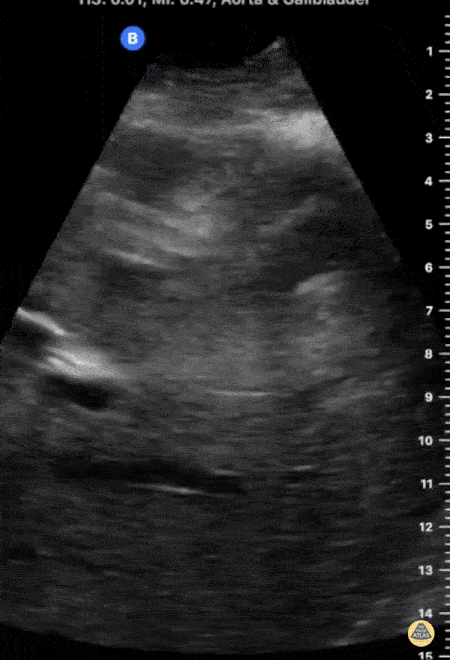
Gallstone Stuck in GB Neck with Shadowing
This image demonstrates a large gallstone lodged in the neck of a distended gallbladder with posterior shadowing. There is no evidence of gallbladder wall thickening seen here.
Jonny Wilkinson, Consultant in ICU and Anesthesia
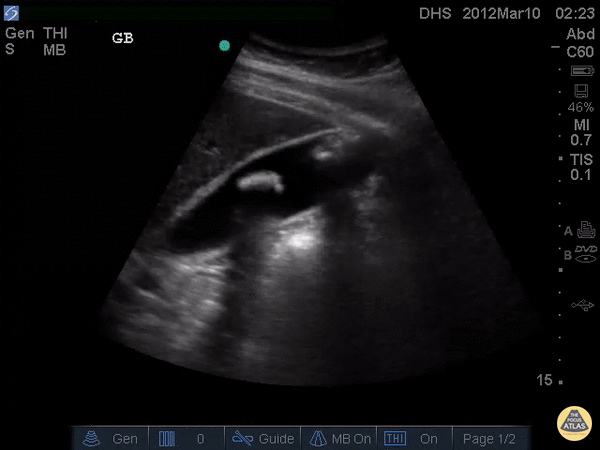
Cholelithiasis, Not Impacted
Two large, hyperechoic stones can be appreciated in this gallbladder. These are likely two stones because of the degree of echogenicity and posterior shadowing. If you have one or two objects in the gallbladder and you're not sure if they're stones, it can be useful to have the patient lay on their side. If the objects moves when the patient moves, they are stones. If not, they are likely polyps or other masses growing from the gallbladder wall.
Justin Bowra MBBS, FACEM, CCPU Emergency Physician, RNSH et al. (Dr. Darmas)
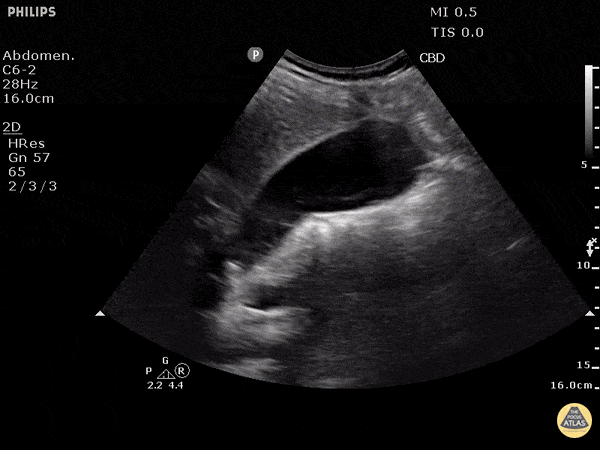
Cholelithiasis with Many Stones
This non-inflamed gallbladder contains many stones. The stones are hyperechoic with posterior shadowing. The gallbladder wall is not thickened, there is no pericholecystic fluid, and no sonographic Murphy's sign, thus cholecystitis is unlikely.
Justin Bowra MBBS, FACEM, CCPU Emergency Physician, RNSH et al. (Dr. Ken Lee)
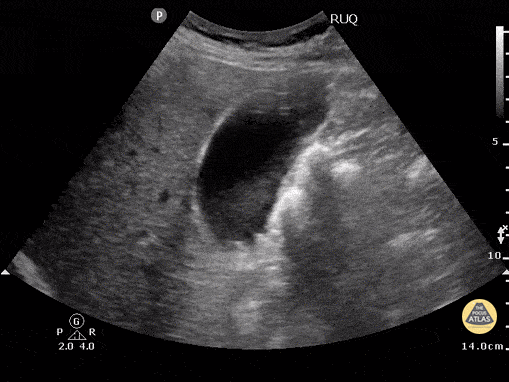
Cholelithiasis - Neck Stones
This patient w/o cholecystitis clearly demonstrates cholelithiasis. A 2002 study showed that ER doctors can diagnose gallstones with a sensitivity of 88% and specificity 96% with POCUS.
Gallstones can be identified by hypoechoic "shadowing" behind hyperechoic stones. If there isn't shadowing, hyperechoic structures could represent polyps or sludge. In this image the stones are resting mainly in the neck of the gallbladder.
Kendall JL, Shimp RJ. Performance and interpretation of focused right upper quadrant ultrasound by emergency physicians. J Emerg. Med. 2001; 21(1):7-13
Submitted by Justin Bowra MBBS, FACEM, CCPU Emergency Physician, RNSH et al.
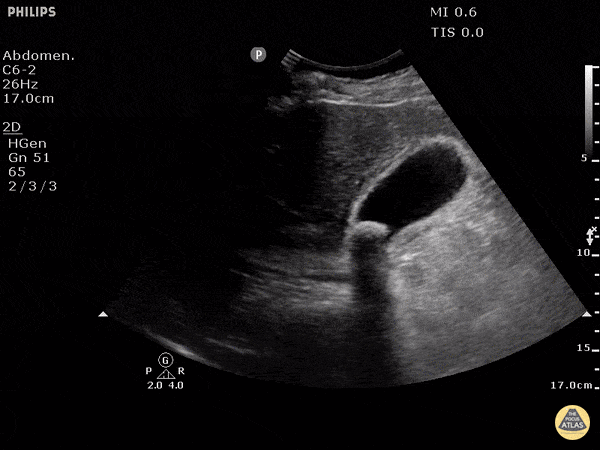
Cholecystitis with Obstructing Stone
This clearly demonstrates a stone in the gallbladder neck as a hyperechoic structure with posterior shadowing. The neck is not always clearly visualized on first glance so it is important to scan through the gallbladder in two planes to exclude stones in the neck. Other signs of acute cholecystitis include pericholecystic fluid, gallbladder wall thickening (>3mm) common bile duct dilatation, and positive sonographic Murphy's sign.
Justin Bowra MBBS, FACEM, CCPU Emergency Physician, RNSH et al. (Mo)
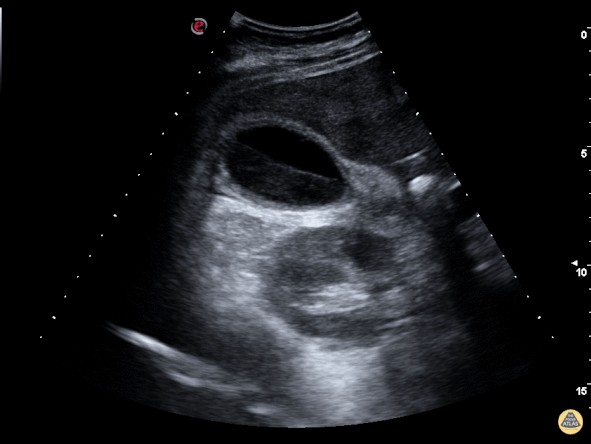
Gallbladder with Biliary Sludge
The image above is from a patient presenting to the emergency department with recurrent abdominal pain. The image demonstrates a large amount of biliary sludge within a normal sized gallbladder. Biliary colic from intermittent obstruction was suspected. While the gallbladder wall is noted to be mildly thick here, cholecystitis was ruled out based on other clinical factors.
Marco Garrone, MD - Torino, Italy
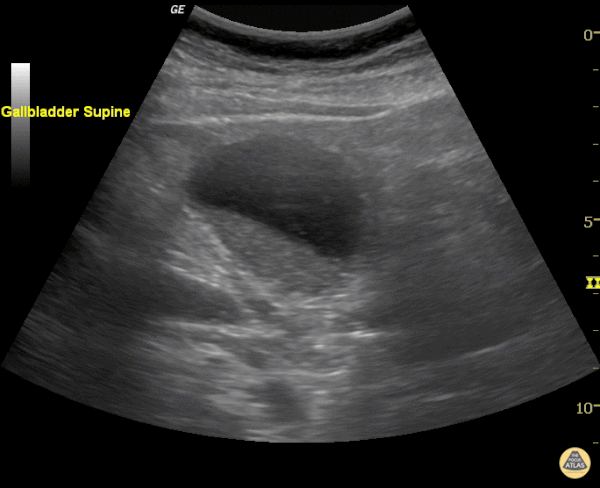
Gallbladder Sludge
Echogenic material can be seen within this gallbladder but there are no stones. It is not bright white (it is not highly echogenic) and furthermore there isn't any shadowing. When there is no shadowing consider polyps or in this case biliary sludge.
Justin Bowra MBBS, FACEM, CCPU Emergency Physician, RNSH et al. (Sharon)
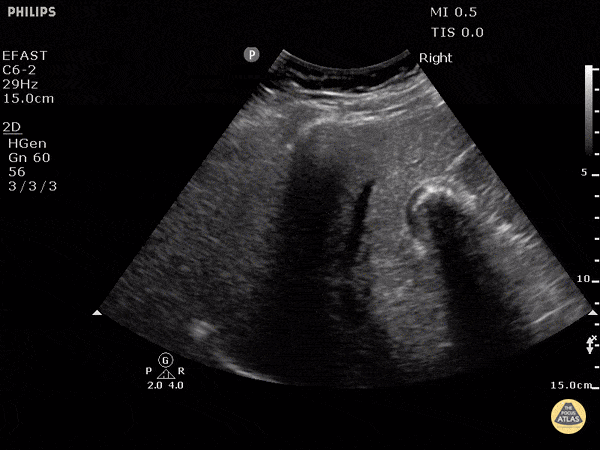
Gallbladder Wall Echo Shadow (WES Sign)
Gallstones can be seen on the right side of the image with a hyperechoic front edge and posterior shadowing.
Justin Bowra MBBS, FACEM, CCPU Emergency Physician, RNSH et al.
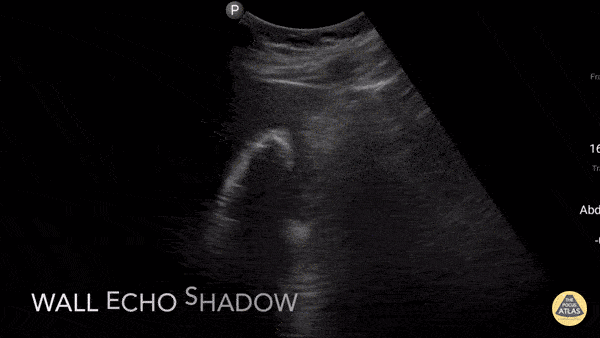
Wall Echo Shadow
Pt with epigastric pain, elevated LFTs and lipase. U/S shows the whole gallbladder shadowed by a large calcified stone or "wall echo shadow-WES." The novice may not be able to find the GB and can mistake WES for bowel (but bowel does not shadow like this).
Dr. Gordon Johnson

Portal Triad
Gallbladder with non-obstructing stone. Fanning down one sees the portal triad with bile duct (black) 7 mm, hepatic artery (pulsitile) and portal vein (red).
Dr. Gordon Johnson
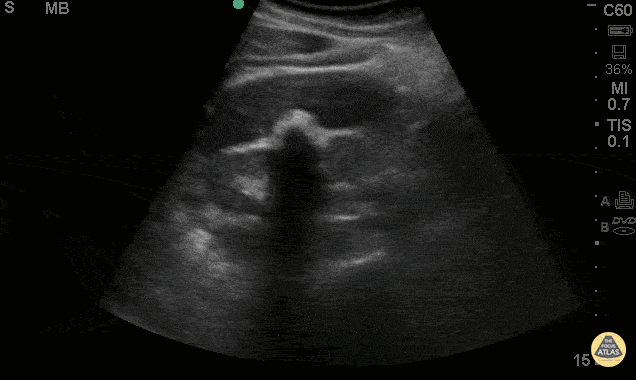
Wall Echo Shadow
38 y/o F presented with abdominal pain, nausea & vomiting. POCUS shows the WES (Wall-Echo-Shadow) sign. This shows a curvelinear hyperechoic line representing the gallbladder wall, followed by a thin hypoechoic line representing a small amount of bile, then a curvelinear hyperechoic line, followed by acoustic shadowing. This sign is seen when the gallbladder has either a large gallstone or multiple small gallstones in a contracted gallbladder taking up the extent of the lumen. Sometimes this sign is misinterpreted as an air filled loop of adjacent bowel.
Jaramillo, Juliana MD; Shah, Rushabh MD; Maurelus, Kelly MD - Kings County Emergency Medicine
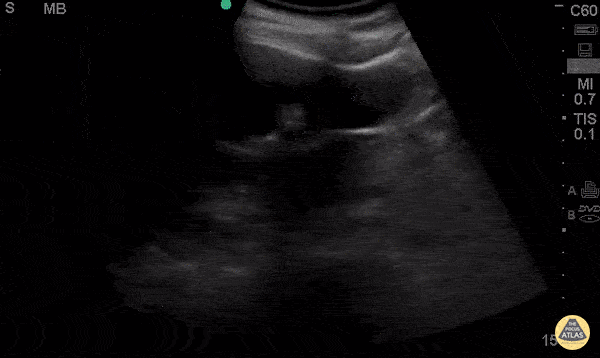
Wall Echo Shadow
38 y/o F presented with abdominal pain, nausea & vomiting. POCUS shows the WES (Wall-Echo-Shadow) sign. This shows a curvelinear hyperechoic line representing the gallbladder wall, followed by a thin hypoechoic line representing a small amount of bile, then a curvelinear hyperechoic line, followed by acoustic shadowing. This sign is seen when the gallbladder has either a large gallstone or multiple small gallstones in a contracted gallbladder taking up the extent of the lumen. Sometimes this sign is misinterpreted as an air filled loop of adjacent bowel.
Jaramillo, Juliana MD; Shah, Rushabh MD; Maurelus, Kelly MD - Kings County Emergency Medicine

Impacted Gallbladder Neck Stone
20s F presented with recurrent postprandial RUQ pain. POCUS demonstrated multiple hyperechoic stones in the gallbladder including one in the gallbladder neck. No pericholecystic fluid or wall thickening were noted, and the common bile duct was normal caliber. Formal RUQ US confirmed these findings, and the patient was taken to the OR by the surgery team for cholecystectomy.
Dr. Nhu-Nguyen Le, Ultrasound Fellow
Denver Health Ultrasound Fellowship



















